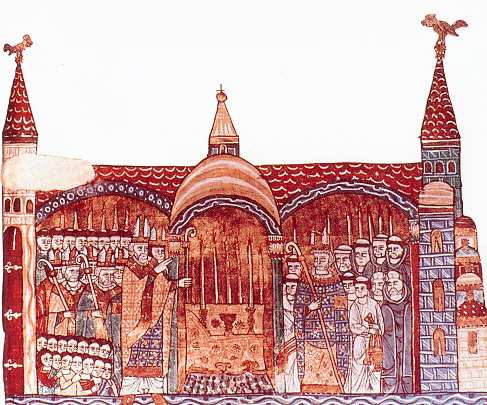|
Medieval Orders
I: The Clergy & the Monks
The following short readings from the
period suggest not only the ideals and failures of monastic and priestly
culture but the practical realities of living in a monastery or as a
parish priest. We will explore these readings using
four sets of perspectives that are drawn from Stassen and Gushee's
work Kingdom Ethics:
-
The Way of Reasoning Dimension
-
The Basic Convictions Dimension
-
The Passions/Loyalties Dimension
-
The Perceptions Dimension
While I will explain these ideas in
class in more detail, you might want to review the Stassen-Gushee
model for yourself. Keep in mind the following questions as you work
through the readings:
"The Monastic
Ideal" from Peter Damiani (MR 49-56)
-
What are the chief values
and convictions of Damiani?
-
What is the monastic ideal
concerning life, wealth, place, desires, food, clothing, the body, and
tears?
"The
Cistercian Order" from William of Malmesbury (MR 57-58)
-
What are the chief
convictions of Stephen (Harding)?
-
Where do his chief
loyalties lay?
-
Why does he leave for
Citeaux? What is his view of potential change?
-
What do you think
motivates the rules for the new order?
"How the
Friars Came to Germany" from Jordan of Giano (MR 59-63)
-
What ethical virtues or
qualities are prized by the writer (Jordan of Giano)?
-
Why are they prized? (i.e.
What practices give them meaning?)
"A Preacher
and His Miracles" from Salimbene (MR 64-66)
-
What kind of audience
would find these accounts interesting or attractive?
-
How does this account
differ from the previous one by Jordan?
"Monastic
Reform in the Fifteenth Century" from John Busch (MR 67-70)
-
What guides the decisions
of the Bishop regarding the monastery of St. Martin at Ludinkerka?
-
What are his convictions,
loyalties, and perception of potential change?
"Archbishop
Baldwin of Canterbury" from Giraldus Cambrensis (MR 71-72)
-
Why do certain of
Baldwin's traits serve him well as a monk but not so well as an
archbishop?
-
What is Giraldus' final
assessment of Baldwin?
"A Model
Parish Priest: St. Gilbert of Sempringham" from John Capgrave (MR
73-74)
-
Describe Gilbert's
character?
-
Why does he teach the
practices to the people that he does? What is accomplished by them?
"An Attempt
to Enforce Clerical Celibacy" from Ordericus Vitalis (MR 75-77)
-
Apply the four dimensions
of the Stassen-Gushee model to this situation. What should we conclude
about what happens?
-
Would you have done things
differently? Why or why not?
"The Habits
of Priests in Normandy" from Odo of Rigaud (MR 78-81)
-
What are we to conclude
about church discipline as a practice, set of loyalties, attempt at
promoting change?
-
Would you have done things
differently? Why or why not?
|
